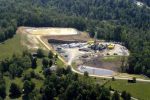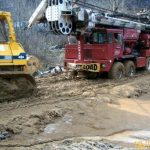- Like
- Digg
- Del
- Tumblr
- VKontakte
- Buffer
- Love This
- Odnoklassniki
- Meneame
- Blogger
- Amazon
- Yahoo Mail
- Gmail
- AOL
- Newsvine
- HackerNews
- Evernote
- MySpace
- Mail.ru
- Viadeo
- Line
- Comments
- Yummly
- SMS
- Viber
- Telegram
- Subscribe
- Skype
- Facebook Messenger
- Kakao
- LiveJournal
- Yammer
- Edgar
- Fintel
- Mix
- Instapaper
- Copy Link
Road width, and single land vs. double lane roads.
Drillers can drill wells using access roads that are wide enough for two tractor trailers to pass each other going in opposite directions, or they can drill wells using single lane roads with occasional wide spot pull-offs or landings for trucks to pass by each other. The advantage of single lane roads to the surface owner is less timber cutting and generally less disturbance to the surface owner’s property (particularly on roads cutting across hill sides where a wider road means a higher cut bank/high wall on the uphill side). The advantage of double lane roads to the surface owner is if the surface owner wants a nice wide road to develop the property where the road is going. Drillers generally do not like single lane roads, particularly for Marcellus Shale well access roads, because they will have to coordinate passing of the trucks going in opposite directions only at the pull-offs and landings, but they can do this using radios etc.
The drillers can get by with a single lane road that is only 12 feet wide, though that is tight. They would probably prefer a more generous 16 foot wide road. Any single land road will need wide spots and landings for trucks going in opposite directions to pass each other. A double lane road generally needs to be 32 feet wide. Note that this is just the width of the driving lane. If the road needs a ditch, the right of way will have to be wider. If the road is up the side of a hill, the cut bank/high wall on the uphill side needs to be sloped back to keep it from, over time, sloughing onto the road, and that will take more width.
In-sloping vs. out-sloping.
The most effective way avoid erosion when building a road along the side of a hill is to put a ditch on the uphill side of the road with frequent culverts under the road that are at least 14 inches in diameter, and then slope the road toward the ditch. The water will run off the road into the ditch, down the ditch to the culvert, through the culvert under the road, onto a rock garden to disperse the energy of the flow, where it will then soak into the ground. This “in-sloping” road construction is the only way the road should be constructed if the road is going up the hill at greater than a 7% grade.
There are two problems with in-sloping road construction. First, the right of way cut through the trees has to be wider to accommodate the ditch. Second, a more important problem, is that roads constructed this way have to be maintained by periodically digging out the ditches and clearing the culverts. Our experience is that this kind of maintenance is almost never ever done by the driller after the well goes into production! If the driller does not do this, the surface owner has the right to call the state Office of Oil and Gas inspector to try to get maintenance requirements enforced, and surface owners should do this for existing roads, but our experience is that the success rate is not great. So a surface owner generally only should want in-sloping roads if the surface owner is prepared to do the ditch and culvert maintenance – and if the road goes up the hill at a greater than 7% grade up the hill.
For roads less than 7% grade up the hill, we recommend that the road be constructed by out-sloping it toward the downhill side. The water just runs off the down hill side of the road along the entire edge of the road and soaks into the ground. This avoids having a ditch to maintain and keeps the right of way through the forest narrower. This has been recommended to us by professional land managers and by our research in the literature.
Road slope.
Also, we believe that no road should have a greater than 10% slope up the hill. This is for two reasons. First, controlling the erosion down the road with any slope greater than that is very difficult, and the driller is unlikely to agree to the rock etc. on the slope that would have some chance of doing that. Second, the tractor trailers and some other vehicles and equipment the driller uses during the drilling process will lose traction trying to get up the hill. (For very long up-hill climb’s 8% may be best.) The driller will solve the tractor trailer’s traction problems this by pushing or pulling them up the slope with bulldozers, and a mess will be made.
There is however a disadvantage to less slope on the road, and that is that the driller will need a longer road to climb to the same elevation of the well using less slope. You may prefer to have them use a shorter, steeper road cutting less timber, but we think the trade off is usually not going to be worth it.
The State’s Erosion and Sediment Control Manual allows them to do 20% slopes and allows the Inspector to waive that, and without talking to your first! We think that is outrageous. We think 10% or even 20% should only be waived if you want them to use an existing road (other than your driveway) which would save cutting trees, and only with appropriate rocking etc. And if the existing road it too steep and you insist on a new road that does not violate slope requirements you will end up with a much better road, though again more timber cutting.
At the other extreme, a road with absolutely no slope is not a good idea. During rainy weather the water will not run off the road, it will just lay on the road, perhaps in puddles, resulting in soft surface, resulting in huge ruts caused by the next vehicle, causing more puddling etc. So it is good for a road to have some slope of up to 2.5%.
Conclusion for surface owners who also own their minerals who are negotiating leases.
If you own both the surface and minerals and are negotiating a lease, put these provisions in an addendum. If they insist they cannot do that because they may run into problem situations, assure them that you want the well drilled too, and put in the addendum that these limits and conditions can be avoided by the driller with the written consent of the surface owner. If they still will not budge, add, “which consent shall not unreasonably be withheld.”
Conclusion for surface owners (or fee owners who have signed leases).
If you are the surface owner (or if you own surface and minerals and you or your predecessor have already signed a lease without these kinds of protections), and if the driller came to you before filing the permit but will not do what you want with the well site or access road locations etc., then you should let the driller know that you are going to use this information to comment on the permit application if he does not do what you want. And if he does not do what you want, then when you get a copy of the permit application you should use this information to comment on the driller’s permit application to drill a well on your land. Maybe, just maybe, the State will make him change it.
To learn more about how generally the comment process works, get the “West Virginia Surface Owners’ Guide to Oil and Gas” and see other links on the WVSORO website. Specifically, if you do not like their proposed well site or access road location, you can comment using what you have learned here. The drillers plan for the location of the well site and access road will be on the WW-9 form included in the permit application. Make a general comment that the location of the road makes it unable to meet these standards you want. (If you can figure out the information/sketch on the form, you will be able to point out the places where the 10% and even 20% road slope limitations are being exceeded. Where the slope is 7% or less ask for out-sloping. Where the road is on level ground, comment that you want it relocated to where it can be out-sloped. Where the road is already on the side of a hill, comment that you want it out-sloped or sloped up the hill a little.) (Even more powerful, if the road on the permit does not even meet the standards of the Soil Erosion and Sediment Control Field Manual of the State Office of Oil and Gas, you can point that out in your comments, and the State almost has to make changes based on those comments. That Manual is also available on the WVSORO website.) These comments may get the State to make the driller move them. Your comment on slope/to move the road is more likely to be successful if you can show a better location for the road that will have less slope etc. Or if you are OK with the well site and access road locations, but want them built to these specifications, the State may make them do that.
Conclusion for surface owners or fee owners who have already had roads put on them.
If you already have a road on you that is not being maintained by clearing ditches and culverts, by allowing huge mud wallows, etc. take pictures and e-mail or send them to the State Office of Oil and Gas in Charleston to complain. That may help, but we cannot guarantee it.


